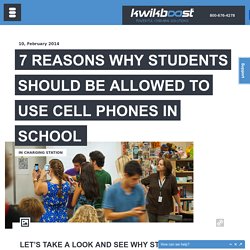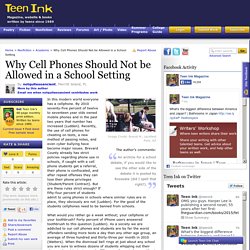

News and Features. Using Smartphones in the Classroom. By Edward Graham Found in: Advice and Support Ken Halla knows a thing or two about using technology in the classroom.

For the past 5 years, the 22-year teaching veteran has worked to transition his ninth-grade World History and AP Government classrooms into a mobile device-friendly environment where students can incorporate the latest technology into the learning process. Along the way, Halla created three of the most used education blogs in the country—“World History Teachers Blog,” “US Government Teachers Blog,” and “US History Teachers Blog”—to help fellow humanities teachers incorporate more technology and more device-based learning into their own classrooms. “Not every classroom can get a laptop every day, so [devices like smartphones], even if you have to pair up, become something useful for teachers,” Halla says. “The number of kids with phones has just been blown out of the water the last couple of years,” he adds. Ensuring it stays academic Apps for the social sciences. 7 Reasons Why Students Should Use Cell Phones in School. 1.

In Preparation for a Real World Job Most working people benefit from having their cell phones on them. They can access their email, call clients, check inventory, read the news, use software applications, and more. Students need to learn how to use their cell phones responsibly (see next tip!). 2. Students know they shouldn’t use their cell phones in school to play Angry Birds, or listen to music, or text their friends about the quiz they just took. 3. Administrators often take notes on their phones as part of teacher observations. Why Cell Phones Should Not be Allowed in a School Setting. In this modern world everyone has a cellphone.

By 2010 seventy-five percent of twelve to seventeen year olds owned mobile phones and in the past two years that number has increased (Ludden). Recently, the use of cell phones for cheating on tests, a new method of passing notes, and even cyber bullying have become major issues. Brevard County already has strict policies regarding phone use in schools, if caught with a cell phone students get a referral, their phone is confiscated, and after repeat offenses they can lose their phone privileges (Student/Parent Contract). But are these rules strict enough? If fifty-four percent of students admit to using phones in schools where similar rules are in place, they obviously are not (Ludden). What would you rather go a week without; your cellphone or your toothbrush? Health effects aside, it is well know that texting in class has become a growing epidemic. Allowing cell phones in school is a danger to the health and education of students.
Cell Phones in the Classroom Pros and Cons. Cell phones are an inevitable part of everyday life in today’s world.

The majority of people in the world own and regularly use cellular phones, including students. The age that people are getting their first cell phones is becoming younger and younger with each generation, raising a large problem in schools. Cellphones in the Classroom: Distraction or Tool? The final version of the National Education Technology Plan (NETP) was released last week, setting forth the Obama Administration's plan for improving access to and integration of technologies for teaching and learning.

Among the recommendations the Department of Education makes in the NETP is a call for support for "efforts to ensure that all students and educators have 24/7 access to the Internet via devices, including mobile devices, and that states, districts, and schools adopt technologies and policies to enable leveraging the technology that students already have. " The push for "24/7 access to the Internet" falls under another the auspices of yet another endeavor, the National Broadband Plan. But the call for better access to Internet-ready devices, particularly utilizing tools the students already possess is an interesting one. Because the device that is ubiquitous for American students isn't the desktop computer or the notebook or the netbook or the iPad.
It's the cellphone.